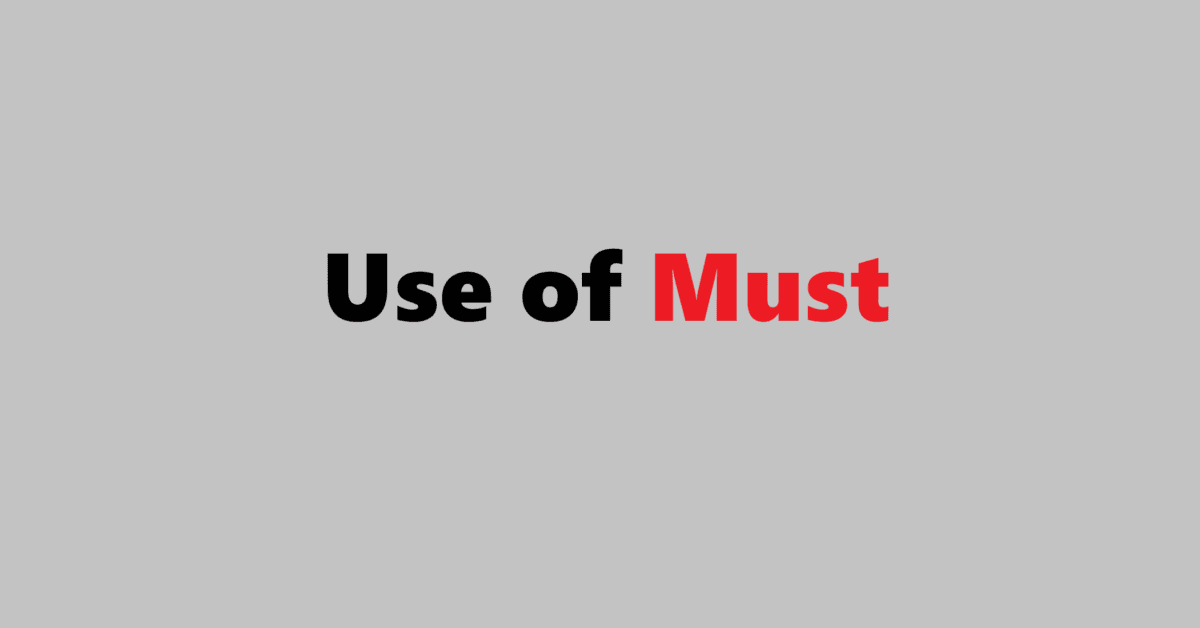In the realm of English grammar, modal verbs play a crucial role in conveying necessity, obligation, possibility, and permission. Among these modal verbs, “must” stands out, not only for its strong implication of obligation or necessity but also for its ability to unequivocally emphasize the importance of an action or decision. In this blog post, we will explore the uses of “must,” providing detailed explanations and practical examples to illustrate its various applications.
Understanding “Must”
At its core, “must” is used to express a strong necessity or obligation. It implies that something is not just a suggestion or recommendation, but rather something that is essential or unavoidable. Additionally, it signals certainty or logical deduction, bridging necessity with confidence in reasoning. The versatility of “must” can be broken down into several key uses: necessity (e.g., “You must finish your homework”), obligation (e.g., “We must uphold the law”), prohibition (e.g., “You must not enter this area”), deduction (e.g., “He must be home by now”), and advisability (e.g., “You must try their special dessert”).
1. Expressing Necessity
One of the primary uses of “must” is to indicate that something is necessary. This includes situations where an action is essential to achieve a specific goal.
Example:
- “You must finish your homework before you can go out to play.”
In this example, finishing the homework is a condition that must be met before the child can enjoy leisure activities. The speaker emphasizes that completing the homework is a necessary step.
2. Indicating Obligation
“Must” can also denote a sense of obligation, usually stemming from rules, laws, or social norms. It signifies that the subject is obligated to comply.
Example:
- “All employees must wear identification badges while on the premises.”
Here, “must” reflects a company policy that mandates employees to comply with a specific dress code regarding identification. It reinforces the obligation to follow the rule.
3. Prohibition
Interestingly, “must” can also be used in the negative form to indicate prohibition. In this case, the use of “must not” (often contracted to “mustn’t”) highlights that something is prohibited or forbidden.
Example:
- “You mustn’t park your car here.”
In this sentence, “mustn’t” conveys a clear prohibition against parking in a specific location, indicating the action is not allowed.
4. Deduction or Logical Conclusion
“Must” is often employed in making deductions or logical conclusions about circumstances. It implies that the speaker is drawing a definitive conclusion based on the available evidence.
Example:
- “She must be at least 18 years old if she is driving a car.”
In this case, the speaker infers that the woman, by virtue of driving, must meet the legal age requirement. The use of “must” reinforces the logic behind the conclusion.
5. Advisability
Another notable use of “must” is in offering strong advice or recommendations. In this context, it conveys a sense of urgency or importance but is typically more assertive than using “should.”
Example:
- “You must try the chocolate cake at that bakery; it’s the best in town!”
Here, the speaker passionately recommends trying the cake, urging the listener to make it a priority, suggesting that missing out would be a regret.
Contextual Usage of “Must”
Formal vs. Informal
The use of “must” can vary depending on the formality of the context. In formal writing, such as legal documents or academic papers, “must” is often used to state requirements and obligations clearly. In casual conversation, people may opt for synonyms or alternative phrases, such as “have to” or “should,” but “must” retains its strength.
Example in Formal Context:
- “All participants must adhere to the guidelines set forth in the orientation manual.”
Example in Informal Context:
- “You really have to see that new movie; it’s fantastic!”
“Must” vs. Other Modals
“Must” is often compared with other modals like “have to,” “should,” and “ought to.” While they share some similarities, their nuances differ significantly:
- Must vs. Have to: “Must” conveys a stronger sense of obligation than “have to” which can imply external necessity.
- Example: “I must report this incident” (imperative); “I have to report this incident” (external requirement).
- Must vs. Should/Ought to: “Should” and “ought to” suggest recommendations and advisability rather than urgent necessity.
- Example: “You must go to the doctor” (obligation); “You should go to the doctor” (recommendation).
Negative Form
To negate “must,” simply add “not” to form “must not” or “mustn’t.” This can show prohibition, as mentioned earlier.
Example:
- “You must not leave the room during the exam.”
This sentence gives a clear directive against leaving, stressing the importance of remaining seated.
Conclusion
The modal verb “must” is integral to understanding the nuances of obligation, necessity, deduction, and prohibition in English. Its usage conveys imperative ideas, whether it mandates action or suggests strong recommendations. In formal contexts, “must” often carries a strong sense of obligation or necessity, suitable for settings like academic writing or professional communication. Conversely, in casual settings, it might be used more flexibly or conversationally, sometimes even with a softer tone. As you incorporate “must” into your speaking and writing, consider its context, formality, and the strength of obligation you wish to convey.
By mastering the use of “must,” you not only enhance your English language skills but also become more adept at expressing your thoughts with clarity and authority. Whether you’re crafting essays, composing emails, or engaging in conversation, a strong grasp of “must” will serve you well. So the next time you want to assert the importance of an action or convey necessity, remember the power of “must” at your disposal.



